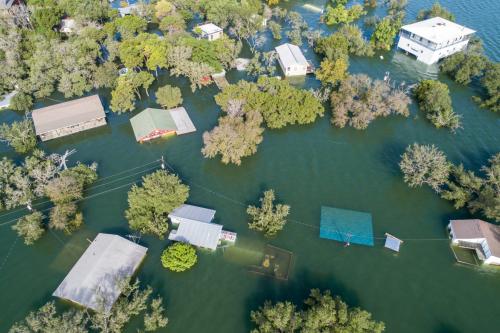Amid a series of major infrastructure negotiations in 2021, Congress made a huge decision. Legislators removed the Clean Electricity Performance Program (CEPP)—a kind of carrot-and-stick system to reduce power plant emissions—from the Build Back Better Act in favor of tax credits. Enough legislators and private interests preferred this approach for it to move forward, even as many others warned that greenhouse gas (GHG) emissions reductions would likely be smaller.
Regardless of the Build Back Better Act’s uncertain future, the CEPP negotiation is a microcosm for the complicated communication environment now facing public officials. Solving the climate crisis demands a level of collective action that tests even the healthiest of democracies. Interventions will be expensive, and everyone will pay something—but the costs of inaction will be even higher. Public officials are going to need public buy-in to adopt the right kinds of multiyear, high-priced policies to address climate change at scale.
The country needs accessible, standardized metrics to make sure legislators and the public share a clear understanding of the climate tradeoffs—like the CEPP versus tax credits debate—written into legislation and other policy reforms. That’s especially the case at the federal level, where policy choices will touch the most people and places.
It is time for the federal government to take a leading role in scoring legislation for climate impacts, not just budgetary impacts. Scoring legislation with a standardized and approachable metric (“GHG per dollar”) would provide the federal government with a consistent method to track progress toward climate goals, inform the negotiation of climate policy, and report back to voters on the sometimes-invisible climate impacts of legislation.
Scoring climate impacts starts with modeling, and we’re fortunate that emissions modeling is a rigorous and growing field. The Environmental Protection Agency has conducted inventory assessments of the country’s GHG emissions and sinks since the 1990s. Monitoring activities are also conducted at a regional-, local-, and even facility-level scale, enabling stakeholders to take stock of the current baseline of climate-related activity. When local and regional actors consider new infrastructure projects, they can reference best practices to measure climate-related costs and benefits.
Emissions modeling has already proven nimble enough to keep up with congressional negotiations over the past year; experts have been modeling the GHG emissions impacts of both the infrastructure bill and the Build Back Better Act. These models have highlighted critical differences between potential climate provisions and identified alternative pathways to meet emissions reduction targets. Specifically:
- Researchers at the Rapid Energy Policy Evaluation and Analysis Toolkit (REPEAT) project modeled the GHG impacts of the Build Back Better Act with and without the CEPP. Without the CEPP, GHG emissions reductions dropped from 1,506 million metric tons (mmt) to 1,159 mmt—falling below the 50% reduction benchmark (1,500 mmt) the country is aiming for under the Paris Agreement.
- Resources for the Future (RFF) modeled electricity sector emissions outcomes in a baseline scenario and eight alternative combinations of the CEPP, the Clean Energy for America Act (CEAA) tax credit extensions, and two versions of a carbon fee. They found a baseline emission reduction scenario of 43%, with the most aggressive policy combination (CEPP, tax credits, and a central carbon fee) reducing electricity sector emissions by 94% by 2030.
- Energy Innovation modeled legislative emissions impacts by presenting the infrastructure bill and the Build Back Better Act together. They estimate the impacts of each provision across four key scenarios: low, moderate, and high efficacy, as well as the baseline. They also modeled the moderate energy sector scenario with and without the CEPP, finding that clean energy could comprise 61% to 69% of all generation in 2030 without the CEPP, but up to 80% of with it.
The assortment of models can pose challenges for communication and consistency. Some modelers frame their key findings in total emissions, others in reductions relative to benchmarks. Models may attempt to represent emissions impacts across the economy or just in select sectors. And just as there is no perfectly true set of economic assumptions to feed into a budget score, emissions modeling can be somewhat subjective. Differing underlying assumptions and methods shape final model outputs, leaving an opening for legislative “greenwashing.”
Modelers who choose to apply overly generous assumptions and methods can vastly overstate the climate benefits of legislation and mislead decisionmakers. For instance, the emissions impacts of transit investments can vary greatly depending on usage and behavioral assumptions—a transit line that nobody rides does not cut emissions, while a transit line that decreases the number of car commuters can have a transformative impact. As the window of opportunity to mitigate and minimize the impacts of climate change narrows, our country can’t afford to invest in greenwashed legislation.
This is where standardization and trust come into play. Legislators and the public need a transparent, consistent, and high-quality measurement system to easily understand the tradeoffs between different climate interventions.
Fortunately, this kind of measurement approach is already used by the Congressional Budget Office (CBO), whose staff sets and follows a litany of technical rules for scoring the budgetary impact of bills. As a nonpartisan actor, it is expected to use best-in-class techniques and transparent methods. CBO scores communicate an estimate of the budgetary impact of legislation, but because each CBO score follows the same rules, it builds credibility. Legislators, journalists, and others regularly use CBO scores to compare different legislative proposals, allowing individuals to not just gauge the impact of a single bill, but assess comparative budgetary impacts across bills.
A federal climate scoring process modeled after the CBO’s budget scoring process could provide a similar Rosetta Stone for the assessment of legislative climate tradeoffs. Only with a clear, standardized evaluation system can we hold ourselves accountable to the promises we’ve made on climate.
This scoring system should adhere to at least two key principles:
First, the federal entity responsible for designing and managing the scoring scheme should be nonpartisan and as independent as possible. Climate issues are too culturally sensitive—and the interventions too sizable—to allow politics to interfere. The measurement approach will need to be highly transparent, including explanations of where the techniques adhere to or diverge from leading scientific techniques. CBO is a logical landing place and could work with federal scientific agencies who already model climate conditions.
Second, the scoring system must resonate with the broader public. It’s not enough for only climate experts to understand key tradeoffs among competing policy ideas. The general public—including private households and businesses—will bear the brunt of unchecked climate impacts and will pay for the policy interventions to reduce them. The public needs to understand their choices. Reporting GHG emissions per dollar is an attractive idea, since general audiences are used to comparing dollars to various outcomes.
It’s time to get pragmatic about federal climate policy. The public wants to reduce our carbon footprint—and we want legislation to help reach those goals. Experts also have the tools to measure legislative tradeoffs, chart them against our goals, and inform the tough decisions that will shape our federal approach to climate. With a trusted, nonpartisan body setting and following best-in-class climate scoring standards, policymakers and voters alike can make informed decisions and chart real pathways toward a more sustainable future.
The Brookings Institution is committed to quality, independence, and impact.
We are supported by a diverse array of funders. In line with our values and policies, each Brookings publication represents the sole views of its author(s).







Commentary
It’s time to start scoring legislation on climate impacts
January 3, 2022